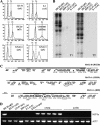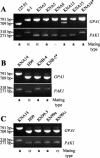Sexual cycle of Cryptococcus neoformans var. grubii and virulence of congenic a and alpha isolates
- PMID: 12933823
- PMCID: PMC187335
- DOI: 10.1128/IAI.71.9.4831-4841.2003
Sexual cycle of Cryptococcus neoformans var. grubii and virulence of congenic a and alpha isolates
Abstract
Cryptococcus neoformans is a human-pathogenic fungus that has evolved into three distinct varieties that infect most prominently the central nervous system. A sexual cycle involving haploid cells of a and alpha mating types has been reported for two varieties (C. neoformans var. neoformans, serotype D, and C. neoformans var. gattii, serotypes B and C), yet the vast majority of infections involve a distinct variety (C. neoformans var. grubii, serotype A) that has been thought to be clonal and restricted to the alpha mating type. We recently identified the first serotype A isolate of the a mating type which had been thought to be extinct (strain 125.91). Here we report that this unusual strain can mate with a subset of pathogenic serotype A strains to produce a filamentous dikaryon with fused clamp connections, basidia, and viable recombinant basidiospores. One meiotic segregant mated poorly with the serotype A reference strain H99 but robustly with a crg1 mutant that lacks a regulator of G protein signaling and is hyperresponsive to mating pheromone. This meiotic segregant was used to create congenic a and alpha mating type serotype A strains. Virulence tests with rabbit and murine models of cryptococcal meningitis showed that the serotype A congenic a and alpha mating type strains had equivalent virulence in animal models, in contrast to previous studies linking the alpha mating type to increased virulence in congenic serotype D strains. Our studies highlight a role for sexual recombination in the evolution of a human fungal pathogen and provide a robust genetic platform to establish the molecular determinants of virulence.
Figures








Comment in
-
Updated view of Cryptococcus neoformans mating type and virulence.Infect Immun. 2003 Sep;71(9):4829-30. doi: 10.1128/IAI.71.9.4829-4830.2003. Infect Immun. 2003. PMID: 12933822 Free PMC article. No abstract available.
Similar articles
-
Molecular genetic analyses of mating pheromones reveal intervariety mating or hybridization in Cryptococcus neoformans.Infect Immun. 2002 Sep;70(9):5225-35. doi: 10.1128/IAI.70.9.5225-5235.2002. Infect Immun. 2002. PMID: 12183574 Free PMC article.
-
[Mating types, sexual reproduction and ploidy in fungi: effects on virulence].Mikrobiyol Bul. 2009 Jul;43(3):507-13. Mikrobiyol Bul. 2009. PMID: 19795629 Review. Turkish.
-
In vitro mating of Colombian isolates of the Cryptococcus neoformans species complex.Biomedica. 2007 Jun;27(2):308-14. Epub 2007 Aug 21. Biomedica. 2007. PMID: 17713641
-
Recapitulation of the sexual cycle of the primary fungal pathogen Cryptococcus neoformans var. gattii: implications for an outbreak on Vancouver Island, Canada.Eukaryot Cell. 2003 Oct;2(5):1036-45. doi: 10.1128/EC.2.5.1036-1045.2003. Eukaryot Cell. 2003. PMID: 14555486 Free PMC article.
-
Variability of phenotypic traits in Cryptococcus varieties and species and the resulting implications for pathogenesis.Future Microbiol. 2010 May;5(5):775-87. doi: 10.2217/fmb.10.44. Future Microbiol. 2010. PMID: 20441549 Free PMC article. Review.
Cited by
-
A unique chromosomal rearrangement in the Cryptococcus neoformans var. grubii type strain enhances key phenotypes associated with virulence.mBio. 2012 Feb 28;3(2):e00310-11. doi: 10.1128/mBio.00310-11. Print 2012. mBio. 2012. PMID: 22375073 Free PMC article.
-
Cryptococcus neoformans mitochondrial genomes from serotype A and D strains do not influence virulence.Curr Genet. 2004 Oct;46(4):193-204. doi: 10.1007/s00294-004-0521-9. Epub 2004 Aug 7. Curr Genet. 2004. PMID: 15309505
-
Cryptococcus neoformans Recovered From Olive Trees (Olea europaea) in Turkey Reveal Allopatry With African and South American Lineages.Front Cell Infect Microbiol. 2019 Nov 8;9:384. doi: 10.3389/fcimb.2019.00384. eCollection 2019. Front Cell Infect Microbiol. 2019. PMID: 31788454 Free PMC article.
-
Recombination hotspots flank the Cryptococcus mating-type locus: implications for the evolution of a fungal sex chromosome.PLoS Genet. 2006 Nov 3;2(11):e184. doi: 10.1371/journal.pgen.0020184. PLoS Genet. 2006. PMID: 17083277 Free PMC article.
-
Phenotypic Plasticity in the Productions of Virulence Factors Within and Among Serotypes in the Cryptococcus neoformans Species Complex.Mycopathologia. 2022 Feb;187(1):65-83. doi: 10.1007/s11046-021-00597-3. Epub 2021 Oct 25. Mycopathologia. 2022. PMID: 34697686
References
-
- Anya, A. O. 1976. Physiological aspects of reproduction in nematodes. Adv. Parasitol. 14:267-351. - PubMed
-
- Barton, N. H., and B. Charlesworth. 1998. Why sex and recombination? Science 281:1986-1990. - PubMed
-
- Bell, G. 1982. The masterpiece of nature: the evolution and genetics of sexuality. University of California Press, Berkeley.
Publication types
MeSH terms
Substances
Associated data
- Actions
- Actions
- Actions
- Actions
Grants and funding
LinkOut - more resources
Full Text Sources
Other Literature Sources

